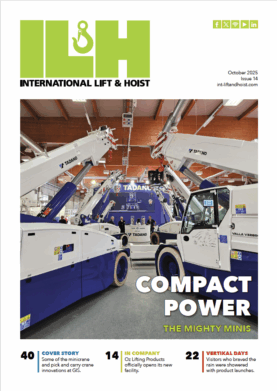Conference Review: Slinging in Harmony
By Keith Norbury
Harmonizing safety regulations in the crane and hoist industries in western Canada emerged as the over-arching theme at the inaugural Crane & Rigging Conference (CRC) Canada. Crane professionals from the western provinces and many from elsewhere in Canada and the United States attended the two-day event in Edmonton, Alberta. Most noteworthy was a strong contingent from the oil sands in Fort McMurray, Alberta.
The event was a partnership between Maximum Capacity Media, All Canadian Training Institute (ACTi), and PEAK Inspection & Training, jointly sponsored by Columbus McKinnon Corp. and Continental Chain & Rigging.
The concept was to better prepare for growth in Canada’s heavy industries and work to towards harmonization of the standards and safety codes relevant to cranes and rigging between the four western provinces, namely British Columbia, Alberta, Saskatchewan and Manitoba. Receiving top billing was a panel discussion on the second day featuring government representatives, safety experts and high profile end users. It didn't disappoint.
By the time the conference concluded at the Alberta capital’s Fantasyland Hotel, the theme had expanded to cover all of Canada, and beyond, with U.S. delegates also voicing a desire to be included in the harmonization of standards.
Knut Buschmann, president of Unirope Ltd., said: "I think you do yourself a disservice if you really limit this to the four [western] provinces."
The comments during and after the panel discussion were the climax of a conference that featured a packed schedule of presentations, each jammed with technical information, ranging from the durability of synthetic slings to the procedures involved in undertaking an engineered lift.
Fred Wolsey, systems engineer for cranes and hoists at Ontario’s Bruce Power nuclear power station, explained the challenges and successes of refurbishing the facility’s aging overhead cranes.
Slings
Rigging and slings were hot topics throughout the event. "One of the things that really got my attention was the wet slings," said Don Barron, ACTi, referring to a nugget from a presentation by Mike Gelskey Sr., president and CEO of Lift-It Manufacturing, that a synthetic sling loses 15 percent of its lifting capacity when wet. "How many riggers know that?" asked Barton.
"It hit me like a ton of bricks about 30 years ago that if really didn’t matter how good a product anyone builds, if people don’t know how to use them properly, it really doesn’t matter," said Gelskey.
A recurring message from Gelskey was that even a tiny nick can greatly reduce the capacity of a synthetic sling.
Fraser Cocks, executive director of the British Columbia Association for Crane Safety, kicked off the conference with a lively and polished review of how that province devised its detailed accreditation system for construction crane operators.
Over two days, information ranged from the simple, such as folding a sling over a hook to prevent the sling from bunching and losing its strength, to a discussion of the impact of the D/d ratio on sling capacity. Mike Riggs, president of the Rigging Institute, covered both those areas and more in his presentation. The big "D" stands for the diameter of load while the little "d" stands for the diameter of the sling wrapped around the load, he explained.
Breaks gave delegates the opportunity to peruse an exhibit area featuring displays from a variety of vendors, including Load Systems International, which sponsored the conference’s lunches, associate sponsors Columbus McKinnon Corp. and Continental Chain & Rigging—and many more.
The conference was deemed such a success that moderator Richard Howes, associate publisher and editor, Maximum Capacity Media, announced that a second conference will take place in Edmonton next fall. Look out for announcements.











